Stacking Adaptogens for Maximum Resilience
💡 Introduction: Why Adaptogens Are More Relevant Than Ever
In a world that never slows down — constant notifications, work overload, emotional strain — resilience has become a survival skill.
You’ve probably heard about adaptogens: herbs that help your body adapt to stress. But beyond the hype lies a deep body of science. Adaptogens aren’t stimulants or sedatives — they’re normalizers, restoring balance whether you’re burned out or anxious.
And when used together in the right combinations — or “stacks” — they can amplify one another’s benefits: improving stress tolerance, cognitive function, mood, and immune stability.
In this article, we’ll explore:
🌿 What adaptogens actually do (and how they differ from caffeine or nootropics)
🔬 The science behind stacking them
💪 The best adaptogen combinations for resilience, energy, focus, and recovery
⚖️ Dosage, timing, and safety
By the end, you’ll know how to build your own personalized adaptogen stack to handle life’s challenges with strength, clarity, and calm.
Looking for supplements for This? Click here.
🌱 Part 1: What Are Adaptogens, Really?

🧬 Definition
Adaptogens are natural plant compounds that help the body maintain homeostasis — a state of internal balance.
To qualify as an adaptogen, a plant must:
1️⃣ Be non-toxic at normal doses
2️⃣ Increase resistance to stressors (physical, chemical, emotional)
3️⃣ Exert a normalizing effect on body systems (neither overstimulating nor sedating)
These properties were first described by Soviet scientists in the 1940s, including Dr. Nikolai Lazarev and Dr. Israel Brekhman, who sought herbs to help soldiers and athletes endure extreme conditions.
🌿 How Adaptogens Work
They regulate the hypothalamic–pituitary–adrenal (HPA) axis, which controls the stress response.
When you face stress:
The hypothalamus releases CRH → triggers ACTH → signals the adrenals
The adrenals release cortisol and adrenaline
Adaptogens help by:
🧘 Lowering overactive cortisol when stressed
⚡ Raising low cortisol during fatigue
💪 Supporting mitochondrial energy production
🌿 Enhancing serotonin, dopamine, and GABA balance
They don’t force an effect — they restore capacity.
⚗️ Part 2: The Science of Stacking Adaptogens
🧩 Why Stack?
No single adaptogen can do everything.
By stacking complementary herbs, you can:
Balance opposing effects (e.g., calming + energizing)
Cover multiple stress pathways (cortisol, inflammation, neurotransmitters)
Reduce the need for high doses of any single compound
Example:
Ashwagandha + Rhodiola + Schisandra → cortisol regulation + energy + endurance.
🧬 The Three Pillars of an Effective Stack
| Pillar | Function | Example Adaptogens |
|---|---|---|
| Calming | Reduces anxiety, regulates cortisol | Ashwagandha, Reishi, Holy Basil |
| Energizing | Boosts stamina and focus | Rhodiola, Ginseng, Cordyceps |
| Stabilizing | Enhances immunity and recovery | Schisandra, Eleuthero, Astragalus |
When stacked correctly, these pillars form a 360-degree resilience system.
🌿 Part 3: Key Adaptogens and What They Do
Let’s break down the most well-researched adaptogens and their main mechanisms.
🌾 1️⃣ Ashwagandha (Withania somnifera) — The Cortisol Balancer
Ashwagandha is the foundation of most stacks.
Key benefits:
Lowers cortisol and stress reactivity
Improves sleep and testosterone balance
Enhances cognitive performance and calm focus
Best form: KSM-66® or Sensoril® standardized extracts.
💊 Dose: 300–600 mg/day.
Best stacked with: Rhodiola for balance, or Reishi for sleep.
❄️ 2️⃣ Rhodiola rosea — The Energy Equalizer
Rhodiola shines when stress causes fatigue or emotional burnout.
Benefits:
Increases energy and endurance
Improves mood and motivation
Enhances serotonin and dopamine regulation
Best form: Standardized to 3 % rosavins, 1 % salidroside.
💊 Dose: 200–400 mg in the morning.
Stack with: Ashwagandha (stress + energy) or Schisandra (endurance).
🍇 3️⃣ Schisandra chinensis — The Endurance Tonic
Schisandra berries support both energy and calm, acting as a dual-direction adaptogen.
Benefits:
Enhances physical stamina and oxygen use
Improves mental clarity
Protects the liver and skin from oxidative stress
💊 Dose: 250–500 mg/day.
Stack with: Rhodiola or Cordyceps for physical performance, or Holy Basil for mood stability.
🌸 4️⃣ Holy Basil (Tulsi) — The Heart Calmer
Known as the “Incomparable One,” Tulsi is revered for its ability to calm the mind and elevate spirit.
Benefits:
Reduces anxiety and restlessness
Balances cortisol
Supports immune response and blood sugar
💊 Dose: 300–600 mg/day or Tulsi tea 1–2× daily.
Stack with: Ashwagandha for deep calm; Rhodiola for balanced alertness.
🍄 5️⃣ Reishi Mushroom (Ganoderma lucidum) — The Deep Restorative
Called “The Mushroom of Immortality,” Reishi is one of the best adaptogens for nervous system repair.
Benefits:
Calms overactive stress response
Enhances deep sleep and immune recovery
Supports liver detoxification
💊 Dose: 1–3 g extract (fruiting body).
Stack with: Ashwagandha or Glycine before bed for nighttime resilience.
🌿 6️⃣ Eleuthero (Siberian Ginseng) — The Original Soviet Adaptogen
Unlike true ginseng, Eleuthero gently boosts energy without overstimulation.
Benefits:
Improves focus and endurance
Reduces fatigue from overwork or illness
Enhances recovery and immunity
💊 Dose: 300–900 mg/day.
Stack with: Schisandra and Rhodiola for long-term stamina.
🌸 7️⃣ Panax Ginseng — The Energy Driver
Known for centuries in Traditional Chinese Medicine.
Benefits:
Boosts ATP (cellular energy)
Enhances mental and physical performance
Supports immune health
💊 Dose: 200–400 mg/day (standardized to ginsenosides).
Stack with: Ashwagandha for balanced vitality.
🌿 8️⃣ Cordyceps — Oxygen and Energy Enhancer
Cordyceps militaris or sinensis increases ATP production and oxygen utilization.
Benefits:
Enhances exercise performance
Improves libido and endurance
Supports respiratory health
💊 Dose: 1000–1500 mg/day.
Stack with: Rhodiola or Schisandra for physical resilience.
🌸 9️⃣ Astragalus membranaceus — The Immune Shield
Astragalus strengthens the body’s Qi — protective energy — and fortifies the immune system.
Benefits:
Promotes long-term vitality
Supports cardiovascular and kidney health
Acts as a gentle immune tonic
💊 Dose: 500–1000 mg/day.
Stack with: Reishi and Eleuthero for immune resilience.
🌿 10️⃣ Bacopa monnieri — The Brain Adaptogen
Bacopa enhances memory, learning, and stress resilience by increasing serotonin and antioxidant defenses.
Benefits:
Improves focus and recall
Reduces anxiety and restlessness
Supports neuroplasticity
💊 Dose: 300 mg/day (standardized to 50 % bacosides).
Stack with: Ashwagandha and Lion’s Mane for brain resilience.
Looking for supplements for This? Click here.
🧩 Part 4: How to Build Adaptogen Stacks
Here’s how to combine adaptogens intelligently for specific goals.
💆 1️⃣ The Calm-Under-Pressure Stack
Goal: Emotional balance and stress control.
| Ingredient | Function |
|---|---|
| Ashwagandha (300 mg) | Reduces cortisol |
| Holy Basil (400 mg) | Calms anxiety |
| Reishi (1000 mg) | Promotes deep rest |
| Magnesium (200 mg) | Supports GABA activity |
✅ Use in evening or high-stress days.
⚡ 2️⃣ The Morning Resilience Stack
Goal: Natural energy and motivation without crash.
| Ingredient | Function |
|---|---|
| Rhodiola (300 mg) | Enhances energy and focus |
| Schisandra (400 mg) | Increases stamina |
| Panax Ginseng (200 mg) | Boosts ATP and alertness |
| B-Complex | Supports neurotransmitters |
✅ Take in the morning with food.
🌙 3️⃣ The Sleep & Recovery Stack
Goal: Deep recovery after long days or workouts.
| Ingredient | Function |
|---|---|
| Reishi (2 g) | Calms nervous system |
| Ashwagandha (300 mg) | Reduces cortisol |
| Glycine (3 g) | Improves sleep depth |
✅ Take 1 hour before bed.
🧠 4️⃣ The Focus & Flow Stack
Goal: Calm alertness for creative or demanding tasks.
| Ingredient | Function |
|---|---|
| Rhodiola (200 mg) | Enhances attention |
| Bacopa (300 mg) | Improves memory |
| L-Theanine (200 mg) | Promotes alpha-wave calm |
| Lion’s Mane (500 mg) | Supports neuroplasticity |
✅ Take mid-morning for cognitive performance.
💪 5️⃣ The Physical Endurance Stack
Goal: Adaptation to physical and environmental stress.
| Ingredient | Function |
|---|---|
| Cordyceps (1000 mg) | Increases oxygen capacity |
| Schisandra (400 mg) | Supports energy metabolism |
| Eleuthero (600 mg) | Boosts stamina |
| Astragalus (500 mg) | Enhances immune recovery |
✅ Use pre-workout or before long workdays.
⚖️ Part 5: Timing, Cycling, and Stacking Rules
⏰ 1️⃣ Match to Circadian Rhythm
Morning: Rhodiola, Ginseng, Schisandra, Cordyceps
Afternoon: Eleuthero, Bacopa
Evening: Ashwagandha, Holy Basil, Reishi
🔄 2️⃣ Cycle Every 8–12 Weeks
Rotate your adaptogens to avoid tolerance. Example:
8 weeks on → 2 weeks off
Switch between calming and energizing blends depending on season or stress levels.
⚗️ 3️⃣ Stack Slowly
Start with one adaptogen, observe for 7 days, then add another.
Track changes in mood, energy, and sleep.
⚠️ 4️⃣ Watch for Overlap
Avoid combining too many stimulating adaptogens (Rhodiola, Ginseng, Cordyceps) or excessive sedating ones (Reishi, Holy Basil) in the same stack. Balance is key.
🧬 Part 6: The Physiology of Resilience

Adaptogens don’t suppress stress; they train your body to handle it better.
This is called stress inoculation — small adaptive challenges that strengthen the system.
They work through:
HPA axis normalization → Balanced cortisol curve
Mitochondrial enhancement → Better energy under pressure
Neurotransmitter modulation → Stable mood and focus
Antioxidant upregulation → Reduced inflammation
Over time, stacking adaptogens can:
Increase heart-rate variability (HRV)
Improve focus and emotional regulation
Shorten recovery time after stress or illness
In other words, you become stress-resilient rather than stress-free.
🩵 Part 7: Supportive Nutrients to Add
Adaptogens thrive when supported by essential cofactors.
| Nutrient | Why It Helps |
|---|---|
| Magnesium | Calms nervous system and muscle tension |
| Vitamin C | Supports adrenal recovery |
| Omega-3s | Reduces inflammation and enhances mood |
| Zinc | Supports hormonal and immune balance |
| B-Complex | Maintains neurotransmitter production |
Combining adaptogens with these nutrients forms a complete resilience ecosystem.
Looking for supplements for This? Click here.
🌈 Part 8: The Mindset of Adaptogenic Living
Adaptogens work best when paired with adaptogenic habits:
Consistent sleep rhythm
Breathwork and mindfulness
Want to try Breathwork? Click Here.
Cold exposure or exercise for hormetic stress
Purpose and connection
These practices mirror the philosophy of adaptogens — using manageable stress to build deeper equilibrium.
🧘 Part 9: Personalized Stacking Strategies
Not all stress is the same. Customize your stack by your primary imbalance:
| Profile | Signs | Suggested Stack |
|---|---|---|
| Burnout Type | Fatigue, apathy, low motivation | Rhodiola + Schisandra + B-Complex |
| Anxious Type | Racing mind, tension, insomnia | Ashwagandha + Holy Basil + Reishi |
| High-Performer | Focused but overstimulated | Rhodiola + L-Theanine + Bacopa |
| Sensitive Type | Easily overwhelmed | Reishi + Tulsi + Magnesium |
| Physical Demands | Athletes or manual work | Cordyceps + Eleuthero + Astragalus |
Adaptogenic stacking is about symmetry, not quantity.
🌙 Part 10: Long-Term Outlook — Building a Resilient Future
When used consistently and intelligently, adaptogen stacks help your body learn flexibility — the hallmark of resilience.
Over months, you may notice:
Calmer mornings even under stress
Stable focus without caffeine
Stronger immunity and faster recovery
A deeper sense of capacity instead of depletion
That’s real resilience — not the absence of stress, but the ability to remain steady in its presence.
Nature’s pharmacy doesn’t just help you survive the modern world; it helps you adapt, evolve, and thrive. 🌿💪
Looking for online therapy ? Click Here.
📚 References
Panossian, A. “Adaptogens: Tonic Herbs for Fatigue and Stress.” Phytomedicine, 2021.
Brekhman, I., & Dardymov, I. “New Substances of Plant Origin Which Increase Non-Specific Resistance.” Annual Review of Pharmacology, 1969.
Sarris, J. “Herbal and Nutritional Interventions for Stress.” Phytotherapy Research, 2020.
Walker, M. Why We Sleep. Scribner, 2017.
Lopresti, A. “Rhodiola and Cognitive Performance.” Frontiers in Nutrition, 2022.
Langade, D. et al. “Ashwagandha and Cortisol Reduction.” Cureus, 2020.
Kennedy, D. et al. “Tulsi and Mental Calm.” Nutritional Neuroscience, 2019.
Panossian, A., Wikman, G. “Phytotherapy of Stress-Related Disorders.” Current Clinical Pharmacology, 2010.
Related Posts
-

How to Measure Your Emotional Growth Over Time
Emotional growth can’t be measured on a scale — but it can be tracked through awareness, regulation, and reflection. Learn how to monitor your emotional evolution using journaling, biofeedback, and science-backed metrics for real progress. 💫
-

The Connection Between Creativity and Resilience
Creativity and resilience share the same roots — adaptability, flexibility, and imagination. Learn how creative expression rewires your brain for strength, helping you transform stress into growth through neuroscience, art, and self-reflection. 🌿
-

Why Cycling Supplements May Improve Long-Term Resilience
Your body adapts to everything — even supplements. Discover why cycling your supplements helps prevent tolerance, boost energy naturally, and build lasting resilience by aligning with your body’s biological rhythms. 🌿
-

The Role of Biofeedback in Emotional Strength
Learn how biofeedback bridges mind and body — helping you monitor heart rate, breath, and brain activity to build emotional strength, resilience, and calm under pressure. See how science meets mindfulness for lasting control. 🌿
-

How to Stay Strong During Long-Term Stress
Long-term stress doesn’t just drain your energy — it rewires your biology. Discover science-backed ways to strengthen your body, balance your mind, and build lasting resilience through breathwork, nutrition, mindset shifts, and supplements that restore calm and focus. 💪
-

Resilience Training for Entrepreneurs
Entrepreneurship isn’t just about strategy — it’s about stamina. Discover how resilience training helps founders stay calm, clear-headed, and adaptable under pressure through neuroscience-backed habits, emotional regulation, and smart supplementation. 🌿
-

How Nootropics Can Boost Emotional Control
Emotions don’t have to control you. Discover how nootropics like L-theanine, ashwagandha, saffron, and omega-3s help balance brain chemistry, improve focus, and strengthen your ability to stay calm and composed under stress. 🌿
-
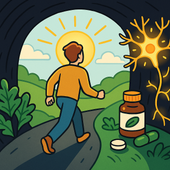
Post-Traumatic Growth and Supplements That Support It
After trauma, true healing means more than survival — it’s transformation. Learn how post-traumatic growth happens in the brain and body, and explore natural supplements like magnesium, ashwagandha, saffron, and omega-3s that support resilience, clarity, and emotional repair.
-

How to Regain Focus After Emotional Stress
After emotional stress, your nervous system feels frayed — your focus fades, thoughts race, and calm seems impossible. Learn how to restore balance, rebuild concentration, and retrain your brain for clarity and peace through evidence-based mind–body tools. 🌿
-

The Future of Sleep Supplements
The future of sleep supplements is here — where science meets nature. Discover how next-generation formulas use adaptogens, amino acids, and biotech innovations to support deep, restorative sleep without dependency. 🌙
-

Emerging Research on Sleep and Nootropics
Can nootropics help you sleep better? Discover how compounds like L-theanine, magnesium threonate, ashwagandha, and Alpha-GPC influence neurotransmitters, circadian rhythm, and brain recovery — bridging the gap between smarter days and deeper nights. 🌙
-

New Herbal Extracts for Deep Sleep
Discover the next generation of herbal extracts for deep sleep — from saffron and magnolia to jujube and lemon balm. Learn how these plant-based compounds calm the nervous system, balance cortisol, and promote truly restorative rest. 🌙
-

Sleep Biohacking: What Works and What Doesn’t
Biohacking your sleep can sound futuristic — from red light therapy to wearables and supplement stacks. But which hacks actually help, and which are just hype? Discover the science-backed sleep strategies that truly improve rest, recovery, and brain health. 🌙
-

Sleep Support for People with Anxiety Disorders
💭 A restless mind can keep you up all night — thoughts spinning, heart racing, and peace feeling far away. Learn how to quiet overthinking, regulate your nervous system, and create a nightly ritual that teaches your brain to let go and rest deeply. 🌙
-
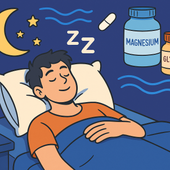
How to Fall Back Asleep After Waking Up
Waking up in the middle of the night? Learn how to fall back asleep quickly and calmly using breathing techniques, stress-reducing rituals, and natural supplements like magnesium and glycine. Restore your body’s rhythm and wake up feeling refreshed.
-

The Role of Omega-3s in Sleep Quality
-

Stacking GABA and Glycine for Deeper Rest
Discover how stacking GABA and glycine can help you achieve deeper, more restorative sleep. Learn how these calming amino acids work together to relax your mind, soothe your body, and improve overall sleep quality—naturally and safely.
-

Overcoming Jet Lag with Supplements
✈️ Jet lag doesn’t have to ruin your trip! Discover how supplements like melatonin, magnesium, L-theanine, and tart cherry can help you reset your body clock faster, reduce fatigue, and recover energy naturally after long flights. 🌙
-

Managing Sleep During Times of Stress
Feeling wired and restless? Learn how to manage sleep during stressful times through nutrition, breathwork, and natural supplements like magnesium and L-theanine. Discover how to calm your nervous system and restore deep, peaceful rest—even when life feels overwhelming.
-

The Role of Magnesium for Night Cramps
Night cramps keeping you awake? Discover how magnesium helps relax muscles, balance electrolytes, and prevent painful spasms. Learn which forms work best, how to take them, and how to pair them with other nutrients for cramp-free, peaceful sleep.
-

Supplements That Reduce Nighttime Awakenings
🌙 Discover science-backed supplements that help you stay asleep through the night. From magnesium and L-theanine to glycine and ashwagandha, learn how these natural compounds calm your nervous system, balance cortisol, and prevent 2 a.m. wake-ups for deeper, more restorative rest.
-
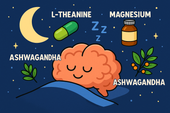
Nootropics That Promote Calm and Rest
Explore the world of calming nootropics — natural brain enhancers that promote relaxation, better focus, and deeper rest. Learn how L-Theanine, magnesium, ashwagandha, and other adaptogens help balance your nervous system, reduce stress, and support restorative sleep.
-

Best Natural Supplement Stack for Sleep
Discover the best natural supplement stack for deep, restorative sleep. Learn how nutrients like magnesium, L-theanine, glycine, and calming herbs such as chamomile and ashwagandha work together to relax your body, calm your mind, and improve sleep quality—naturally and safely.
-
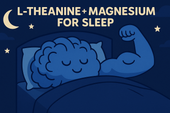
Combining L-Theanine and Magnesium for Sleep: A Calm Night, Naturally
Discover how combining L-Theanine and Magnesium can help you drift into deep, restorative sleep. Learn how this natural duo calms the mind, relaxes the body, and supports your nervous system—without grogginess the next morning.
-

How to Sleep Better After Intense Workouts
Struggling to fall asleep after a tough workout? Learn how to optimize your post-training recovery with nutrition, hydration, and science-backed sleep strategies. Discover how to calm your nervous system, balance hormones, and wake up fully recharged for your next session.
-
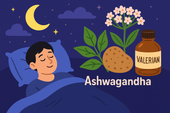
Ashwagandha and Valerian: A Bedtime Combo for Deep Rest and Emotional Reset
Discover the calming synergy of Ashwagandha and Valerian root, two natural sleep aids that help quiet the mind, ease anxiety, and promote deeper rest. Learn how this herbal duo supports the nervous system, balances stress hormones, and restores emotional peace — without next-day grogginess.
-

How to Create a Resilience-Boosting Diet
Discover how to build emotional and physical strength from the inside out with a resilience-boosting diet 🍎. Learn which foods stabilize your mood, how supplements like magnesium and omega-3s strengthen your stress response, and why pairing nutrition with breathwork and therapy creates lasting calm, focus, and vitality 🌿💪.
-
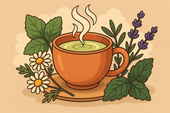
Best Teas and Herbal Blends for Calmness: Nature’s Way to Restore Inner Peace
Ashwagandha, the ancient adaptogenic herb, helps your body find balance during stress. Known as “Indian ginseng,” it supports cortisol regulation, boosts energy, and restores calm clarity. Discover how this powerful root promotes resilience, emotional balance, and steady vitality — one cup at a time. 🌸
-

Parenting and Emotional Strength: How to Raise Children Without Losing Yourself
Empathy is the bridge that connects hearts — the quiet power to understand, feel, and support another’s emotions without judgment. Learn how empathy strengthens relationships, enhances communication, and cultivates deeper compassion in everyday life. 🌿
-
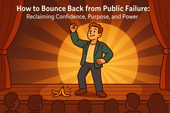
How to Bounce Back from Public Failure: Reclaiming Confidence, Purpose, and Power
Visualization is more than imagination — it’s brain training for resilience. By picturing calm, success, or healing, you activate the same neural pathways as real experience. Learn how daily visualization rewires your brain for confidence, emotional balance, and recovery from stress. ✨
-

Coping with Financial Stress Through Resilience: How to Stay Grounded When Money Feels Tight
Body awareness is the foundation of emotional resilience. By tuning into your body’s signals — tension, fatigue, or calm — you learn to recognize stress before it overwhelms you. Discover how mindfulness, gentle movement, and breathwork can deepen your connection with your body and restore balance from the inside out. 🧘
-

How to Stay Positive During Chronic Illness: A Guide to Emotional Strength and Hope
Creativity is more than art — it’s a form of healing. Whether through painting, writing, music, or small acts of expression, creativity helps release emotion, calm the nervous system, and reconnect you to joy. Discover how to use creativity as a tool for emotional balance, resilience, and self-discovery. 🌿
-

Resilience Tips for Caregivers: How to Stay Strong While Caring for Others
Joy isn’t the absence of pain — it’s the quiet strength to find light even in challenging times. Cultivating joy through small daily moments restores balance, releases stress, and reminds you of life’s beauty. Learn how to reconnect with authentic happiness, rebuild emotional energy, and nurture your nervous system through gratitude, presence, and play. 🌿
-

Building Resilience After a Breakup: How to Heal, Rebuild, and Rise Stronger
Social connection is one of the strongest predictors of emotional resilience. During difficult times, genuine relationships act as anchors — calming the nervous system, reducing stress hormones, and helping you regain perspective. Learn how cultivating real human connection can strengthen your mind, heart, and overall well-being. 🌿
-

How to Stay Emotionally Strong During Job Loss
Your emotions are powered by brain chemistry — a delicate balance of neurotransmitters like serotonin, dopamine, and cortisol. When these chemicals work in harmony, you feel calm, focused, and resilient. Learn how daily habits, nutrition, and mindfulness can support your brain chemistry and boost emotional well-being naturally. 🌿
-
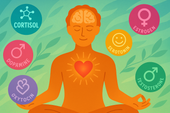
The Role of Hormones in Emotional Stability: How Your Chemistry Shapes Your Calm
Hormones shape more than your body — they shape your emotions, resilience, and sense of calm. From cortisol to serotonin, these chemical messengers influence how you react to stress, connect with others, and recover from challenges. Learn how to balance your hormones naturally to build lasting emotional stability and harmony within. 💫
-

Mitochondria and Emotional Energy: The Cellular Power Behind Your Mood
Breathwork is one of the most powerful tools for emotional regulation and cellular balance. Through intentional breathing, you can calm your nervous system, increase oxygen flow to the brain, and even support mitochondrial energy. Learn how conscious breathing connects body and mind — transforming stress into presence and emotional strength. 🌿
-

Inflammation and Its Impact on Mood Resilience: The Silent Link Between Body and Mind
Inflammation doesn’t just affect the body — it impacts the mind. Chronic inflammation alters brain chemistry, depletes serotonin, and makes emotional recovery harder. Learn how calming inflammation through nutrition, mindfulness, and sleep can restore balance, resilience, and a renewed sense of emotional strength. 💫
-
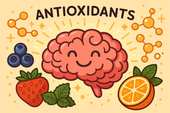
How Antioxidants Protect Emotional Well-being: The Hidden Link Between Oxidative Stress and Mental Health
Antioxidants do more than protect your body — they defend your mind. By neutralizing oxidative stress, antioxidants support serotonin, dopamine, and brain energy pathways that keep you calm, focused, and emotionally balanced. Discover how foods like berries, green tea, and dark chocolate nourish your brain, boost mood, and strengthen resilience from the inside out. 🌿✨
-
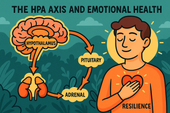
The HPA Axis and Emotional Health: The Hidden Bridge Between Stress and Mind
Neuroplasticity — the brain’s ability to rewire and adapt — is the foundation of emotional healing and resilience. When you face stress, trauma, or change, your neural pathways can reshape themselves to support new patterns of calm, focus, and self-awareness. Learn how daily practices like mindfulness, therapy, and breathwork strengthen neuroplasticity to transform emotional pain into personal growth. 🌸
-
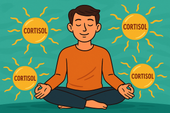
Why Cortisol Control Is Key to Resilience: Mastering Stress to Build Emotional Strength
Controlling cortisol — the body’s main stress hormone — is the secret to lasting resilience. When cortisol levels stay balanced, your mind becomes clearer, emotions steadier, and energy more sustainable. Learn how breathwork, mindset shifts, adaptogens, and daily rhythms can help you calm your stress response and build true inner strength. 🌞💪
-
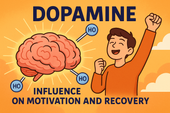
Dopamine’s Influence on Motivation and Recovery: Reigniting Drive and Balance
Healthy relationships are the foundation of emotional balance and resilience. Whether romantic, familial, or platonic, genuine connection releases dopamine, serotonin, and oxytocin — the brain’s “bonding trio” — helping us feel secure, motivated, and seen. Learn how trust, empathy, and communication not only strengthen your connections but also reshape your nervous system for deeper emotional well-being. 🌿🤝
-
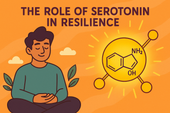
The Role of Serotonin in Resilience: How This “Mood Molecule” Shapes Emotional Strength
Serotonin — often called the “resilience molecule” — plays a vital role in how we handle stress, regulate mood, and recover from emotional challenges. Beyond happiness, this powerful neurotransmitter helps balance the gut-brain axis, stabilize the nervous system, and support emotional flexibility. Learn how nutrition, sunlight, mindfulness, and adaptogens can naturally boost serotonin and strengthen your emotional resilience. 🌞🧠
-
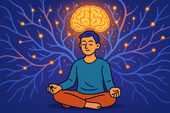
How Neuroplasticity Supports Emotional Growth: Rewiring the Brain for Resilience
Neuroplasticity is the brain’s built-in power to grow, adapt, and heal — and it’s the foundation of emotional transformation. Every mindful breath, compassionate act, or reframed thought strengthens new neural pathways that support resilience and self-awareness. Learn how your brain rewires through daily habits, helping you turn emotional challenges into opportunities for growth and calm. 🌿
-
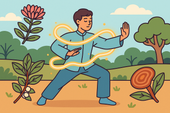
Tai Chi and Adaptogens for Mind-Body Balance: The Art of Harmonizing Energy and Resilience
Alchemy isn’t just an ancient science — it’s a timeless symbol of transformation and inner balance. By blending the physical and spiritual, alchemy teaches us that change begins from within. Just as metals are refined into gold, we too can transmute emotional pain, stress, and chaos into clarity and strength through mindful practice and self-awareness. 🌙✨
-

Cold Therapy and Emotional Control: Training the Mind Through the Body
Cold therapy isn’t just for athletes — it’s a tool for emotional mastery. By exposing your body to controlled cold, you train your nervous system to stay calm under stress, improving focus, mood, and resilience. This article explores the science of cold exposure, its impact on hormones and the vagus nerve, and how ice baths and cold showers can help you build emotional control, one breath at a time. 🧊🧘♂️
-

How Music Influences Emotional Recovery: The Healing Soundtrack of the Mind
Neuroplasticity — the brain’s ability to rewire and heal itself — is at the heart of emotional recovery. Through mindful habits, music, therapy, and consistent mental stimulation, your brain can form new connections that support resilience and well-being. Discover how neuroplasticity turns pain into growth, helping you rebuild balance, focus, and emotional strength. 🌿
-

Nature Therapy for Building Resilience: Reconnecting With the Healing Power of the Earth
Nature therapy helps rebuild emotional resilience by reconnecting you with the healing rhythms of the Earth. From forest walks to sunlight exposure, nature restores balance to your nervous system, lowers stress hormones, and teaches emotional adaptability. Learn how spending time outdoors can enhance mental clarity, calm anxiety, and awaken your natural capacity to heal. 🌞
-

Breathwork Techniques That Pair with Supplements: The Ultimate Synergy for Stress Relief and Mental Clarity
Breathwork and supplements create a powerful mind-body synergy for stress relief, focus, and energy. By combining intentional breathing with adaptogens, nootropics, and calming nutrients, you can naturally regulate cortisol, sharpen mental clarity, and boost emotional balance. This guide explores the best breathwork techniques and supplement pairings to help you feel centered, calm, and energized from the inside out. 🌿

















































